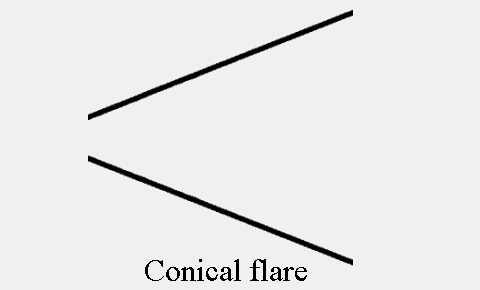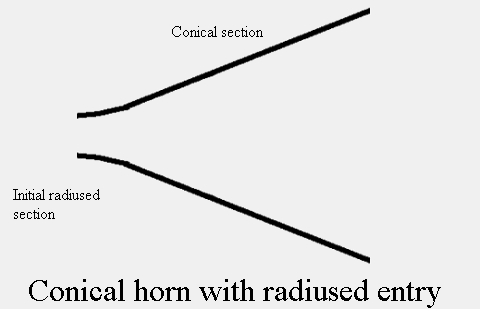Here are some basic descriptions of various horn types:
Salmon shapes:
Conical
Exponential
Hyperbolic
Other shapes:
Tractrix (see "tractory curve")
Radial
Multicell
Constant directivity (CD)
Overview and history:
Horns are used for two reasons:
1. Impedance matching, to raise efficiency
2. Directional control, to put the sound where we want it
Conical and Exponential horns
The simplest and probably oldest horn is the conical horn, which is basically a megaphone. It confines the sound to a narrow radiation angle, thereby increasing sound level in line with the horn. However, it doesn't work as well at low frequency as exponential horns so as soon as that was discovered, most horns were made with exponential flare.
Radial and Multicell horns
A problem that presented itself was that exponential horns tend to beam at high frequencies because the throat is so narrow. This causes the radiation pattern to become more narrow as frequency increases. Multicell horns were an attempt to combat this problem, essentially by making an array of exponential horns splayed to provide a wide coverage pattern. However, this was at the expense of midrange beaming which was excessive in both the vertical and horizontal planes. To improve on this, radial horns were developed which are basically an exponential horn extruded in an arc along the horizontal axis. This makes a horn with straight side walls, setting the horizontal pattern and top and bottom walls with an exponential curve that provide collapsing directivity in the vertical plane. Off-axis response is uniform along the horizontal axis but not at the expense of acoustic loading at low frequencies, which remains good.
Conical horns revisited: Constant Directivity
Exponential horns, both radial and multicell implementations, were the typical horn shapes for loudpeakers up until around 1975. At that time, interest shifted back to conical horns because of their uniform radiation angle.

Conical horns have a characteristic that makes them attractive for certain HF applications - lowered distortion and uniform directivity. Conical horns don't generate as much distortion as exponential horns and they also provide constant directivity, set by the flare walls. Since the mouth edge causes diffraction, directional control is lost at low frequencies. Immediately above the frequency where the pattern widens, it narrows for a small band. Above this point, the wall angle sets the pattern up to the frequency where the throat becomes acoustically large. Above this point, the dimensions of the throat set the pattern.
If the driver generates a spherical wavefront, then the pure conical shape is very good. It will simply confine radiation within the walls of the horn, allowing the spherical wavefront to move through it without modifying the shape of the wavefront. However, a compression driver has a part of the horn built-in to the driver. It also has a phase plug which transforms the shape of the wavefront from sperical to planar. This presents a challenge for any implentation of a conical horn using a compression driver. The exit angle of the driver forms the first part of the horn and the wavefront is planar. So if a pure conical horn is mounted onto a compression driver, the horn wall angle will set the pattern at low frequencies and the compression driver will set the pattern at high frequencies. Since the exit angle of most compresson drivers is around 10o, the horn will beam at high frequencies.
Diffraction - Manta Ray and Bi-Radial horns
To modify the pattern at the upper and lower extremes, some designers have added acoustic features to conical horns. The most useful are diffraction slots or edges used to widen the pattern at frequencies where it begins to narrow. To modify the low frequency transition band where pattern narrows, some horns have the last 1/3rd or 1/4th of the flare angle wider than the main body of the horn, which reduces the narrowing that happens just above the frequency where pattern control is lost. Also, some constant directivity horns have a diffraction slot in the throat to prevent the driver exit angle from setting the pattern at high frequencies. This feature widens the pattern in the top octave, allowing the body of the horn to set the radiation angle at high frequencies.
Quadratic Throat horns
One of the trade-offs encountered when using diffraction edges to shape the pattern is the same features which cause diffraction to occur also cause impedence discontinuty. These transitions create ripples in acoustic impedance, with corresponding ripples in response. To combat this, the throat entry angle is radiused to match the compression driver exit angle. After an intial transition, the main body of the flare is made conical. The radiation pattern is set by the flare walls down to the frequency where mouth diffraction causes it to lose pattern control. Some manufacturers round the mouth edges or surround it with absorbent material to reduce edge diffraction, others simply crossover above this frequency.

At high frequencies, the driver exit angle sets the radiation angle on a horn made as shown above. This kind of horn will beam at high frequencies, just like an exponential horn does. But unlike an exponential horn, the radiation angle is uniform over most of the passband, set by the wall angle of the horn. Only at the highest frequencies does this kind of horn begin to beam, and the narrowing of directivity is not abrupt due to the radiused throat entry.
Tractrix horns
Another horn that has features designed to reduce diffraction is the tractrix horn. It is similar to the exponential horn, in that it has rounded walls that cause collapsing directivity. This shape results in a horn that is slightly shorter than an exponential horn with a wider mouth. The throat entry angle is matched to the driver exit angle and the mouth angle is radiused fully 90o from the axis. Because of the dimensions of the horn, it doesn't load well at low frequencies and the curvature of the walls causes it to beam, but its strength is its smooth transistion from entry to exit.







